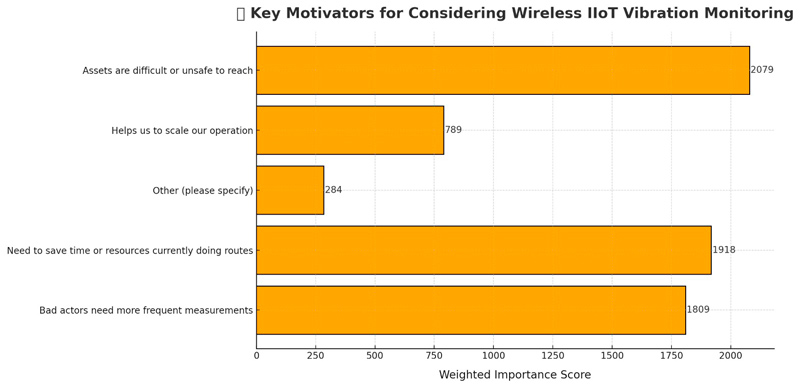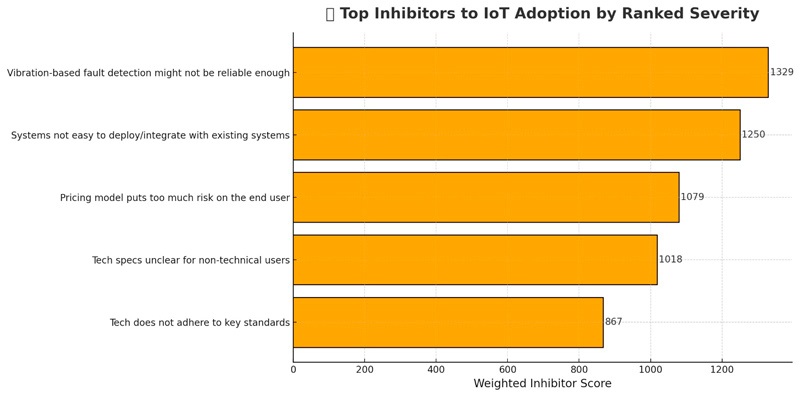How Erbessd Instruments Is Shaping the Future of Predictive Maintenance
In late 2024, Erbessd Instruments proudly sponsored an industry-wide survey—The Landscape of Predictive Maintenance—to better understand how condition monitoring professionals are adapting to a rapidly evolving maintenance landscape.
We partnered with Mobius Institute and Machine Instrumentation to reach more than 300 technicians, analysts, engineers, and maintenance leaders across sectors to uncover real-world challenges, technology adoption patterns, and future priorities. The results? Eye-opening—and incredibly motivating.
Now, we’re excited to share those insights with you.
More than just a snapshot of the current state of predictive maintenance (PdM), this data is helping us fine-tune our innovations, enhance our support, and stay laser-focused on what matters most: your success.
Here’s how Erbessd Instruments is turning insight into action.
Adoption Is Rising, but Maturity Varies
🔹 74% of respondents are pursuing or using predictive maintenance, yet only 23% feel their programs are advanced.
Why it matters:
– Analysts often operate with tools and systems in various stages of readiness. Without program maturity, data consistency and diagnostic accuracy suffer.
– Decision-makers must recognize that PdM success isn’t binary—it’s a gradual evolution. According to ResearchGate (2020), lack of maturity in PdM programs often results in misalignment between investment and outcome expectations.
How Erbessd Is Responding:
We’re committed to meeting customers wherever they are on the PdM journey. From plug-and-play sensor kits to enterprise-level vibration systems, our solutions are modular, scalable, and tailored to every maturity level.

Barriers to Industrial IoT Adoption:
1. “Vibration-based fault detection may not be reliable enough” was the #1 inhibitor reported.
2. Many also cited difficulties with deployment and integration, echoing the findings below that complexity presents a systemic challenge.
3. Pricing risk and lack of clear technical specs for non-experts rounded out the list of prevalent obstacles.
Why it matters:
-For Analysts: Reliability skepticism suggests past experiences with false positives or insufficient insights have left a mark. This concern is reinforced by findings in ResearchGate (2020), which highlight inconsistent sensor performance and limited diagnostic depth as common limitations in early implementations.
-For Decision-Makers: Investment decisions stall when the tech is perceived as immature or opaque—especially to non-technical stakeholders responsible for budget approval. ScienceDirect (2021) underscores that unclear ROI, integration hurdles, and limited internal buy-in are persistent inhibitors to full-scale adoption of condition-based maintenance.
How Erbessd Is Responding:
Erbessd’s hardware is built for the real world—designed, tested, and field-proven in demanding industrial environments to ensure reliability you can trust. We also bridge the gap for non-technical stakeholders with visual dashboards, automated reports, and intuitive alerts that simplify decision-making. And when it comes to integration, our systems are engineered to fit seamlessly into existing workflows, whether you’re augmenting legacy equipment or building from the ground up.
Cost and Complexity Still Stand in the Way
🔹 61% cite implementation cost as a barrier
🔹 45% point to system complexity
Why it matters:
– For Analysts: Complex systems can be overwhelming, increasing the chances of misuse or underutilization. ResearchGate (2020) confirms that insufficient user training and system usability contribute directly to poor outcomes.
– For Decision-Makers: Financial justification can be difficult without immediate savings. According to ScienceDirect (2021), unclear ROI calculations often result in hesitation or abandonment of projects.
How Erbessd Is Responding:
We design with simplicity and ROI in mind. Our wireless sensors, cloud-based dashboards, and intuitive analytics platforms reduce both training overhead and capital expenditure. Learn more about the true ROI of an effective condition monitoring program here:
https://www.erbessd-instruments.com/articles/maximizing-roi-with-condition-monitoring/

Reasons Behind the Results & How Erbessd is Overcoming the Obstacles
Organizational Culture and Change Aversion
Why it matters:
– For Analysts: Resistance at higher levels can undermine their work, regardless of technical accuracy.
– For Decision-Makers: ResearchGate (2020) highlights that management commitment is one of the most influential success factors in CBM implementation.
Data Overload and Skill Gaps
Why it matters:
– For Analysts: They become overwhelmed by “big data” without proper tools or training.
– For Decision-Makers: A shortage of skilled staff creates bottlenecks in data processing and decision cycles.
Integration and Interoperability Challenges
Why it matters:
– For Analysts: Disconnected systems require manual processes that are time-consuming and error-prone.
– For Decision-Makers: Integration issues delay ROI and increase the total cost of ownership.
Financial Constraints and ROI Uncertainty
Why it matters:
– For Analysts: Without funding, analysts lack the hardware and software needed for optimal performance.
– For Decision-Makers: ResearchGate (2020) notes that ROI is one of the most commonly misunderstood or neglected aspects of condition-based maintenance planning.
How Erbessd Is Responding:
Our condition monitoring sensors are built with user-friendliness in mind, offering fast setup and intuitive operation right out of the box. Our software enhances accessibility with clear dashboards, supervised AI-powered diagnostics, and automated reporting that simplifies complex data. With a global network of distributors, we provide localized support and minimize downtime wherever you are both physically and on your CBM journey. And from initial onboarding to advanced training, our team of experts is always available to ensure you’re fully equipped for success
Looking Ahead: Smarter Tools, Better Support
Condition monitoring is becoming more intelligent, and so are we. Responsible, supervised AI-based diagnostics, enhanced remote support, and proactive service models are helping analysts do more—and giving decision-makers the clarity they need to justify ongoing investment.
The Erbessd Commitment
The survey results make one thing clear: success in predictive maintenance isn’t just about tools—it’s about people, experience, and adaptability.
At Erbessd Instruments, we’re future-focused and customer-obsessed. We build tech that works for you, not the other way around.
Let’s shape the future of asset health—together.
📚 References
ScienceDirect. (2021). Overcoming Barriers to Condition Monitoring Adoption. Journal of Cleaner Production, 280, 124458. https://doi.org/10.1016/j.jclepro.2020.124458
García Márquez, F. P., Tobias, A. M., Pinar Pérez, J. M., & Papaelias, M. (2020). Condition-based maintenance implementation: A literature review. ResearchGate.
Megh Howard serves as the Chief Marketing Officer and Director of People & Culture at Erbessd Instruments. This unique combination allows her to unite the company’s outward-facing brand strategy with its internal culture and values—ensuring that how the company shows up for its customers is deeply rooted in how it operates from within.
Megh believes that a strong, people-centered culture is essential to delivering exceptional customer experiences. By fostering an environment where employees feel valued, connected, and empowered, she helps ensure that customer-first values aren’t just part of the marketing message—they’re lived every day across the organization. Her work aligns employee engagement with service excellence, bridging global teams and creating a workplace that mirrors the trust and support Erbessd Instruments extends to its clients and partners.
A graduate of Hudson Valley Community College and Penn State University, Megh brings a thoughtful, relationship-driven approach to leadership—connecting with colleagues, customers, distributors, and industry peers with authenticity and purpose.


